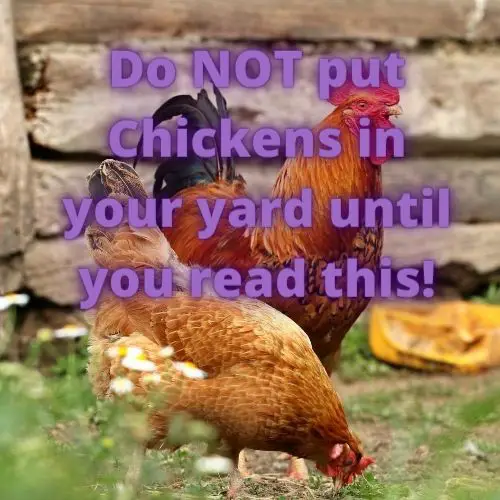
We all love fresh eggs right? Well, those of us that aren’t allergic to them anyway. They are nature’s brilliant binder, all wrapped up in the perfect package ready to go where you need them. Baking, breakfast and multitude of other culinary uses abound – so why wouldn’t you want some chickens to supply them for you free of charge if you have space? The idea of chickens roaming free in our gardens picking out bugs and providing us with eggs is just a little romanticized.
Chickens are great at providing eggs but they can also be very destructive in the garden if you are not aware of their basic characteristics. Your Perfectly groomed vegetable garden and all the hard work getting it there can literally be undone in a few minutes by half a dozen free-ranging chickens. But it doesn’t have to be that way. By simply utilizing the natural instincts of the chicken we can put them to work to benefit our gardens and reduce some of our workloads. The Permaculture Chicken is a friend in the garden.
Adding chickens to the yard is often one of the first things we do when trying to live more sustainably. They are cheap and easy to obtain in most locations and they don’t need a great deal of space. They can be fun and interesting to watch and are a great introduction to country styled living even in the suburbs. Many people find keeping chickens is the quickest and easiest way to put them back in touch with nature. Kids marvel at collecting eggs and feeding the birds some seed or vegetable scraps. What’s not to love?
Chickens in the garden can also be extremely destructive if left to their own devices. Their natural instinct to scratch around looking for the worms and bugs can decimate a well manicured lawn or garden bed very quickly. But if we look into the needs and natural desires of the chicken we can put them to work for us to assist in the building of our gardens and growing our own vegetables.
6 Basic Needs of a Chicken
1. Shelter – All chickens need a place to sleep comfortably and to shelter from extreme weather events. Ideally your chicken shelter will provide a space for roosting as well. Roosting is a natural instinct of the chicken – they prefer to be up off the ground when roosting (sleeping). They need protection from predators too. The last thing you want to find in the morning is that your chickens have been attacked by marauding cats or other wild animals. Keep them safe and sound in a well-built Shelter. The coop does not need to be elaborate or expensive and can be built from recycled materials. It can be fixed or mobile depending on your needs and the systems you will incorporate but more on that later.

2. Nesting Box – Included in your coop design should be a number of nesting boxes. Generally speaking 1 box for every 3 hens is about right. Again nesting boxes do not need to be elaborate. My first hen house used old metal oil drums from the fish and chip shop as nesting boxes. Over the years we have used everything from an old cupboard and chest of drawers to simple wooden bays in our current model. What ever you use it should have good air flow but also make the chicken feel safe and secure during the egg laying or hatching process. Remember to keep it clean with fresh bedding every week or so and obviously remove the eggs daily if you don’t want extra babies running around.

3 & 4 Clean Food and Water – It goes without saying that all animals including chickens need access to fresh water. There are a number of ways to acheive this from simple water dishes to more elaborate setups that deliver water on demand. Either way it is essential to ensure the water containers are cleaned out regularly. When chickens eat they store dirt grit in their cheeks to help them grind up the food (Chickens don’t have teeth right) so when they drink they often drop dirt into the bowl. The water gets dirty and bacteria can begin to develop in the water. So for healthy chickens clean your water dishes out regularly. Similarly with their feeder (which should contain a complete styled cracked grain in dry form) also needs to be kept clean and free from rodents. This grain ideally should be combined with some shell grit or dried crushed egg shells to ensure they get enough calcium. No calcium supplementation means no eggs. So don’t leave this out.
5. Dust Bath – Every chicken loves a good dust bath. There are a few reasons for this but primarily it is how the chicken attends to its own hygiene. By providing a place for them to do this you are allowing the natural characteristic of the chicken to shine through. If you add a little diatomaceous earth (available at your produce store) to the dust bath you will also help them to be free from lice and mites as well.
6. Safe Foraging – Chickens love to scratch around in the soil and dirt looking for little tasty morcels to eat. Worms, spiders, ants, and even the odd grub are all favourites for chickens. But if we do not provide a space for their safety while foraging the chickens are at risk of predators such as hawks and eagles. A shrub or small tree is ideal but anything the chicken can get under will do. Foraging in long grass or garden beds will keep your chickens happy and healthy. They will thank you with wonderful deep coloured egg yolks.

Chickens in Permaculture
Permaculture seeks to integrate rather than segregate. So integrating chickens into the permaculture system is something we can do in a number of ways.
Chickens as we have discovered have some fairly basic needs but for the most part they love to scratch around looking for food. So why not put this natural instinct to good use. Imagine using your chickens to scratch up and prepare your next garden bed or turn over your compost piles. Their inherent desire to kick about in hay or straw and add poop to your piles will have you the envy of your neighbours with the amount of production you have going in a very short period of time.
Some ideas of how you can integrate chickens and stack up the functions in your garden to reduce your workload include placing the chicken coop on a slight slope so that their scratching and kicking is moved to an area for your collection and distribution. Water is not the only thing that flows downhill.
Placing short runs around your garden bed to contain the chickens while they eat the bugs and insects within the vegetable patch and leave free fertiliser behind.
A mobile chicken coop such as the one below with a small mobile electric fence keeps predators out and chickens in and can be used to remediate poor soils and crop lands.

As you can see the humble chicken is a work horse for the small to medium size garden. The image below explains some of the many functions of such a small animal when used in conjunction with other practices.



